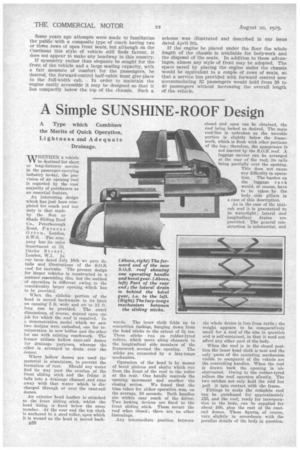A Simple SUNSHINE-ROOF Design
Page 64

If you've noticed an error in this article please click here to report it so we can fix it.
A Type which Combines the Merits of Quick Operation, Lightness and Adequate Drainage.
WHETHER a vehicle be destined for short or long-distance service in the passenger-carrying industry to-day, the provision of an opening roof is regarded by the vast majority of purchasers as an essential feature.
An interesting design which has just been completed for coach and bui4 duty is that made by the Sun or Shade Sliding Roof Co., Peterborough _Road, Parsons Green, London, S.W.G. The company has its sales department at 33, Davies Street, London, W.1. In our issue dated July 16th we gave details and illustrations of the S.O.S. roof for taxicabs. The present design for larger vehicles is constructed in a manner rsaembling this, but the method of operation is different owing to the considerably larger opening which has to be provided.
When the slidable portion of the head is moved backwards to its limit an opening 5 ft. wide and an to 12 ft. long can be provided. The exact dimensions, of course, depend upon the job for which the roof is required. In a demonstration model which we saw two designs were embodied, one for incorporation in new baies and the other for use with existing coachwork. The former utilizes hollow cant-rail domes for drainage purposes, whereas the other is arranged to drain over the domes.
Where hollow domes are used the material is aluminium, to prevent the
formation of rust. Should any water find its Way past the overlap .of the front sliding stick and the fraine it falls into a drainage channel !and runs away with that water which is discharged through or over the cant-rail domes.
An exterior head leather is attached to the front sliding stick, whilst the head lining is fixed below the same member. At the rear end the top cloth is anchored to a steel roller, upon which it is wound as the head is moved backB38
wards. The inner cloth folds up in concertina fashion, hanging down from the head sticks to the extent of n ins. These sticks run on rubber-tyred rollers, which move along channels in the longitudinal side members of the framework around the opening. The sticks are connected by a lazy-tongs mechanism.
Operation of the head is by means of bevel pinions and shafts which run from the front of the roof to the roller at the rear. One handle controls the opening movement and another the closing action. We found that the time taken for either operation was, on the average, 10 seconds. Both handles tire within easy reach of the driver. Two locking devices are fixed to the front sliding stick. These secure the roof when closed ; there are no other fastenings.
Any intermediate position between
closed and open can be obtained, the roof being locked as desired. The main roof-line is unbroken as the movable portion is slightly below the framework, which is flesh with other portions of the top ; therefore, the appearance is not marred by the S.O.S. roof. A luggage carrier can be arranged at the rear of the roof, its rails being partially over the opening. This does not cause any difficulty in operation. The burden on the luggage rack would, of course, have to be taken by the body side pillars in a case of this description.
As in the case of the taxicab roof it,is guaranteed to be watertight ; lateral and longitudinal drains are provided. The general construction is substantial, and
the whole device is free from rattle; the weight appears to be comparatively small for it roof of the size in question and is self-contained, in that it need not affect any other part of the body.
When the roof is in the closed position the inner head cloth is tint and the only parts of the operating mechanism visible to occupants of the vehicle are the controlling handles. When the roof is drawn back the opening is unobstructed. Owing to the rubber-tyred rollers the roof operates silently. The two catches not only hold the rOof but pull it into contact with the frame.
Fittings to make the complete roof can be purchased for approximately £25, and the roof, ready for incorporation in the body, can be supplied for about £60, plus the cost of the cantrail domes. These figures, of course, vary slightly in accordance with the peculiar details of the body in question.




















































































































